Noisy Hawaii volcano lava fissure spurs more evacuations
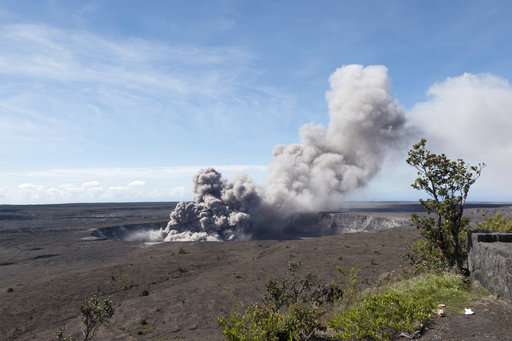
A new fissure emitting steam and lava spatter spurred Hawaii officials to call for more evacuations on Sunday as residents braced for an expected eruption from the Kilauea volcano.
The Hawaii County Civil Defense issued an alert that an 18th fissure was discovered along a road west of a major highway on the Big Island. Residents on that road were being told to evacuate, and two nearby community centers were serving as shelters for people and pets.
Popping, exploding and sloshing sounds could be heard from the fissure as far as 1,500 yards (1,400 meters) away.
The fissures, ground deformation and abundant volcanic gases indicate eruptions on the eastern flank of Kilauea are likely to continue.
The latest opening came the morning after two other fissures opened on Saturday. Most of the lava outbreaks have occurred in and around the Leilani Estates neighborhood, where molten rock has burst through the ground, destroying more than two dozen homes and resulting in evacuation orders for nearly 2,000 people.
The U.S. Geological Survey reported that the 17th fissure, which opened Saturday night, was spattering but no flow had formed. The 16th fissure had spilled lava into an open field earlier in the day.
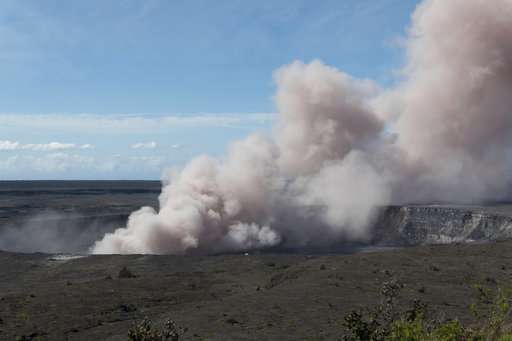
The Hawaiian Volcano Observatory reported the fissures opened just east of the Puna Geothermal Venture energy conversion plant, where steam and hot liquid are brought up through underground wells and the steam feeds a turbine generator to produce electricity. Plant workers last week as a precaution removed 50,000 gallons of a flammable gas stored at the site.
Geologists warn that Kilauea's summit could have an explosive steam eruption that would hurl rocks and ash miles into the sky.
-
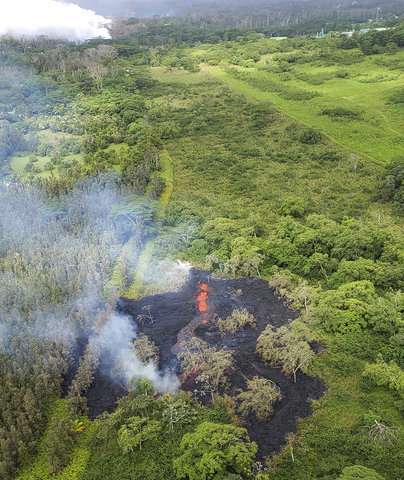
This Saturday, May 12, 2018, image released by the Hawi'i County Fire Department, shows an aerial view of fissure 16, located about 1.3 km (0.8 miles) northeast of fissure 15, top left, i9n the Big Island of Hawaii. The fissure is located 500 m northeast of the Puna Geothermal Venture site, top right. Warnings that Hawaii's Kilauea volcano could shoot boulders and ash out of its summit crater are prompting people to rethink their plans to visit the Big Island. But most of the rest of the island is free of volcanic hazards, and local tourism officials are hoping travelers will recognize the Big Island is ready to welcome them. (Hawi'i County Fire Department via AP) -
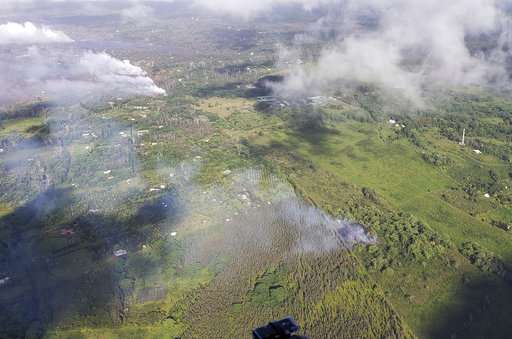
This Saturday, May 12, 2018, aerial image released by the Hawi'i County Fire Department, show a view of fissure 16, bottom right, that erupted this morning beginning just before 7:00 a.m. HST in the Big Island of Hawaii. The fissure is located roughly along the alignment of the earlier fissures, steam in top left photo, and 1.3 km (0.8 miles) northeast of fissure 15 and Pohoiki Road. Warnings that Hawaii's Kilauea volcano could shoot boulders and ash out of its summit crater are prompting people to rethink their plans to visit the Big Island. But most of the rest of the island is free of volcanic hazards, and local tourism officials are hoping travelers will recognize the Big Island is ready to welcome them. (Hawi'i County Fire Department via AP) -
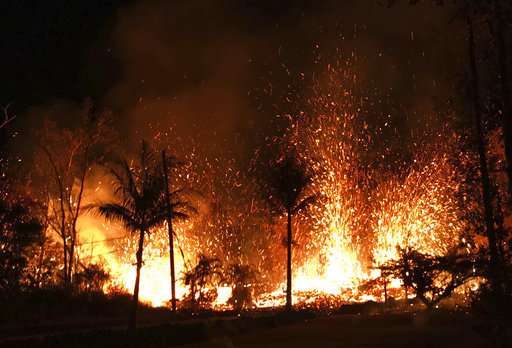
In this Saturday, May 5, 2018, file photo, a new fissure erupts in Leilani Estates in Pahoa, Hawaii. The lava hisses, crackles and pops. It roars like an engine as it sloshes and bubbles. It shoots into the sky, bright orange and full of danger, or oozes along the pavement, a giant bubbling blob of black marshmallow-like fluff, crushing homes and making roads impassable. (U.S. Geological Survey via AP, File) -
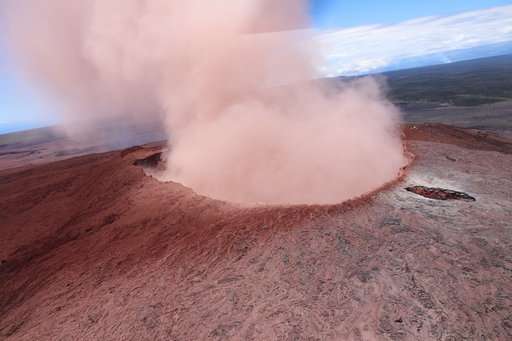
In this May 3, 2018, file photo released by U.S. Geological Survey, a plume of ash rises from the Puu Oo crater on Hawaii's Kilauea Volcano, in Hawaii Volcanoes National Park. Hawaii's Kilauea volcano has spewed lava into the air, destroyed homes, forced residents into shelters, and agitated an otherwise cheerful, small community where everyone is a neighbor. (U.S. Geological Survey via AP, File) -
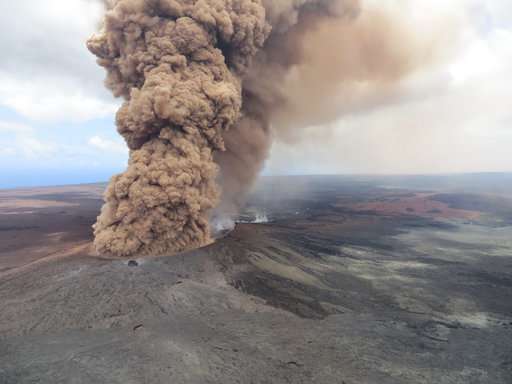
In this Friday, May 4, 2018, file image released by the U.S. Geological Survey, at 12:46 p.m. HST, a column of robust, reddish-brown ash plume rises after an earthquake shook the Big Island of Hawaii, Hawaii. The lava hisses, crackles and pops. It roars like an engine as it sloshes and bubbles. It shoots into the sky, bright orange and full of danger, or oozes along the pavement, a giant bubbling blob of black marshmallow-like fluff, crushing homes and making roads impassable. (U.S. Geological Survey via AP, File) -
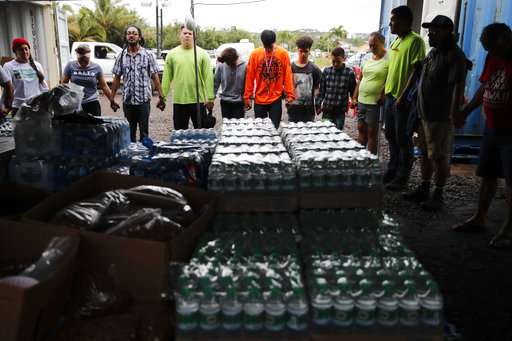
In this May 8, 2018, file photo, volunteers and evacuees hold hands while praying before serving dinner at a makeshift donation center in Pahoa, Hawaii. Hawaii's Kilauea volcano has spewed lava into the air, destroyed homes, forced residents into shelters, and agitated an otherwise cheerful, small community where everyone is a neighbor. Kilauea has long towered over this corner of the Big Island, and is a source of pride, awe and inspiration, but also fear. (AP Photo/Jae C. Hong, File) -
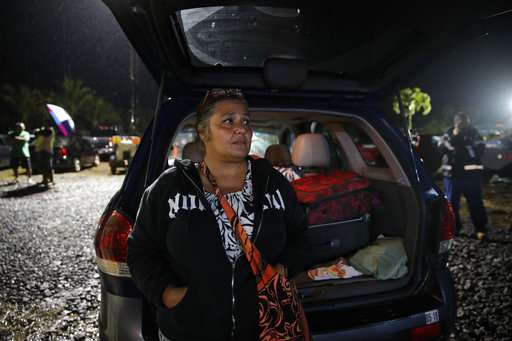
In this May 8, 2018, file photo, evacuee Nina Bersamina, an elementary school teacher, stands next to her SUV loaded with her belongings while waiting to pick up some food at a makeshift donation center in Pahoa, Hawaii. "It's heartbreaking. It's heartbreaking because this is our home," said Bersamina. (AP Photo/Jae C. Hong, File) -
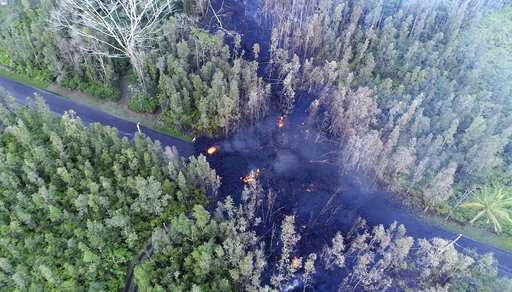
In this May 4, 2018, file frame from video, lava flows over a road in the Puna District as a result of the eruption from Kilauea Volcano on Hawaii's Big Island. The lava hisses, crackles and pops. It roars like an engine as it sloshes and bubbles. It shoots into the sky, bright orange and full of danger, or oozes along the pavement, a giant bubbling blob of black marshmallow-like fluff, crushing homes and making roads impassable. (Byron Matthews via AP, File) -
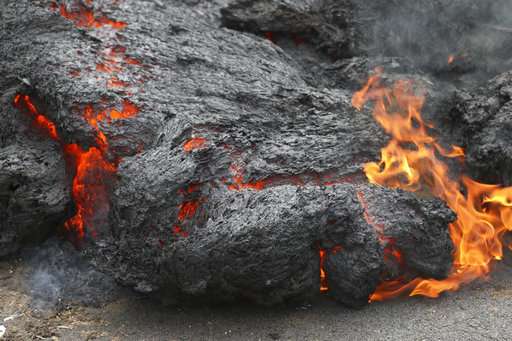
In this May 5, 2018, file photo, lava burns across a road in the Leilani Estates subdivision near Pahoa, Hawaii. The lava hisses, crackles and pops. It roars like an engine as it sloshes and bubbles. It shoots into the sky, bright orange and full of danger, or oozes along the pavement, a giant bubbling blob of black marshmallow-like fluff, crushing homes and making roads impassable. (AP Photo/Caleb Jones, File) -
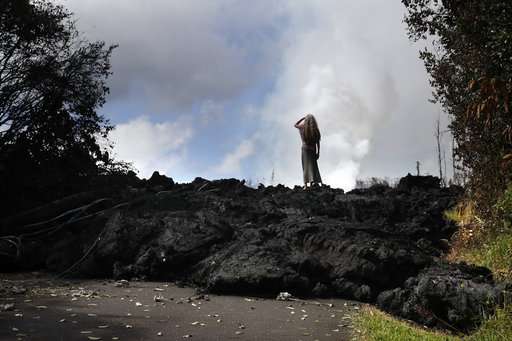
In this May 11, 2018 file photo, Hannique Ruder, a 65-year-old resident living in the Leilani Estates subdivision, stands on the mound of hardened lava near Pahoa, Hawaii. The lava hisses, crackles and pops. It roars like an engine as it sloshes and bubbles. It shoots into the sky, bright orange and full of danger, or oozes along the pavement, a giant bubbling blob of black marshmallow-like fluff, crushing homes and making roads impassable. (AP Photo/Jae C. Hong, File) -
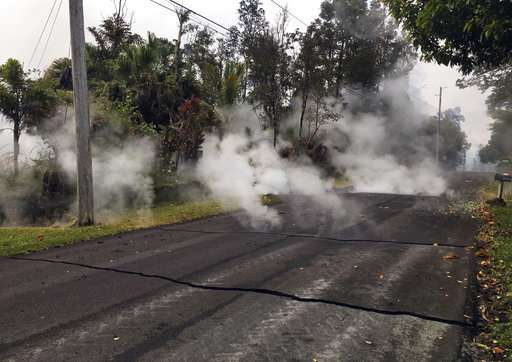
This May 7, 2018, file photo from the U.S. Geological Survey shows gas and steam rising from multiple fissures on Moku Street in the Leilani Estates Subdivision near Pahoa on the island of Hawaii. The lava hisses, crackles and pops. It roars like an engine as it sloshes and bubbles. It shoots into the sky, bright orange and full of danger, or oozes along the pavement, a giant bubbling blob of black marshmallow-like fluff, crushing homes and making roads impassable. (U.S. Geological Survey via AP, File) -

In this May 10, 2018 file photo visitors view Kilauea's summit crater outside the Jaggar Museum in Volcanoes National Park, Hawaii. Kilauea has long towered over this corner of the Big Island, and is a source of pride, awe and inspiration, but also fear. (AP Photo/Jae C. Hong, File) -
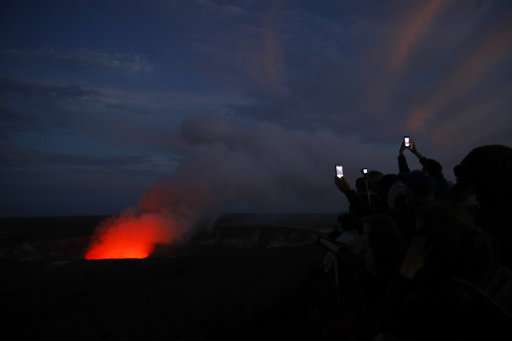
In this May 9, 2018, file photo, visitors take pictures as Kilauea's summit crater glows red in Volcanoes National Park, Hawaii. The lava hisses, crackles and pops. It roars like an engine as it sloshes and bubbles. It shoots into the sky, bright orange and full of danger, or oozes along the pavement, a giant bubbling blob of black marshmallow-like fluff, crushing homes and making roads impassable. (AP Photo/Jae C. Hong, File)
© 2018 The Associated Press. All rights reserved.



















